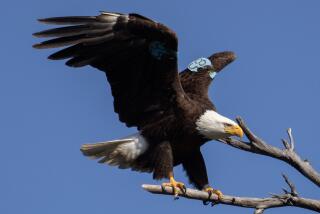Bald Eagle and Peregrine Falcon Soar Away From the Pit of Extinction
- Share via
OLD FIELDS, W. Va. — The bald eagle in flight is a riveting spectacle, its white head and white tail feathers contrasting starkly with its dark-brown six-foot wings as it soars high above the South Branch of the Potomac River.
In its nearby nest in a tall white pine, one of two known eagle nests in West Virginia, two fledgling chicks wait to be fed, perhaps with a fish the hunting parent finds along the river bank.
“No matter if it’s the first or the 250-thousandth eagle you see, it does something to you inside,” said Terry Ingram of Apple River, Ill., who may have counted more eagles than any other American. “It mesmerizes you.”
In Nampa, Ida., ornithologist Tom Cade stands in a field and peers through binoculars at a peregrine falcon nesting atop a 150-foot sugar-storage elevator.
Cade, through his Peregrine Fund, has led the way in bringing back from near extinction the streamlined killer, capable of knocking other birds out of the sky in 200-m.p.h. dives.
Bald eagles and peregrines have three things in common: Both are birds of prey, or raptors. Both are on the federal endangered-species list. And both are making a dramatic comeback.
Neither has attracted as much attention lately as has a fellow raptor, the spotted owl, the focal point of the controversy over logging practices in the Pacific Northwest.
But birds of prey inevitably attract some attention. Worldwide, they make up 288 species. They include eagles, hawks, owls and falcons. They are graceful fliers, efficient hunters, energetic cleanup crews of rodents and carrion.
They are creatures of romance and mystery, engendering human fascination. Occasionally they engender outright dislike, as when they kill chickens or small pets. This sometimes results in their deaths by shooting or poisoning, despite educational campaigns and federal protection.
In the United States, the bald eagle flies in a league of its own. It has been the national symbol since 1782.
Daniel L. James, who oversees the endangered-raptors program for the U.S. Fish and Wildlife Service, points to the bald eagle’s “exciting increase.”
In the nation’s early years, before white settlers’ westward expansion, between 25,000 and 100,000 eagles flew unchallenged. As European civilization spread, eagles gradually declined. By 1963, under the onslaught of the insecticide DDT, the decline had become catastrophic. Only 400 nesting pairs remained in the entire United States.
DDT was banned in 1972. Since then, bald eagles have gradually recovered. By 1989, according to Fish and Wildlife Service estimates, 2,660 pairs of bald eagles were nesting in the United States.
This recovery has led the service to consider reducing the eagle’s classification from endangered to threatened, a proposal that quickly generated opposition.
Among those who object to reclassification is Edward E. Clark Jr., president of the Wildlife Center of Virginia.
“The proposed reclassification plays politics with the most treasured wild animal in our society,” Clark wrote James. Citing a 40% breeding failure among bald eagles on Chesapeake Bay in 1989, he also warned of new, dangerous pesticides: “Until such known threats which can be removed are removed, the eagle must not be reclassified.”
Arguing the other way is Terry McEneaney, an ornithologist at Yellowstone National Park, Wyo., home of 14 nesting pairs of bald eagles. Other specific laws besides the Endangered Species Act protect the eagle, and McEneaney would like to see reclassification so that more money could be spent on less-known raptor species.
But veterinarian Patrick Redig, founder of the Raptor Research and Rehabilitation Program in St. Paul, Minn., has doubts about bald eagles despite the current successes.
“There’s a lot of pressure on them,” he told National Geographic. “We’re on kind of a plateau right now. But the future of the bald eagle is not guaranteed.”
DDT was the nemesis of the peregrine falcon too. The bird disappeared in the eastern United States, and only 10% survived in the West. Cade, then an ornithology professor at Cornell University, founded the Peregrine Fund in 1970. He now lives in Boise, Ida., where the fund has operated the World Center for Birds of Prey since 1984.
The fund has hatched about 3,000 peregrines in captivity and released them in 28 states.
More to Read
Sign up for Essential California
The most important California stories and recommendations in your inbox every morning.
You may occasionally receive promotional content from the Los Angeles Times.










